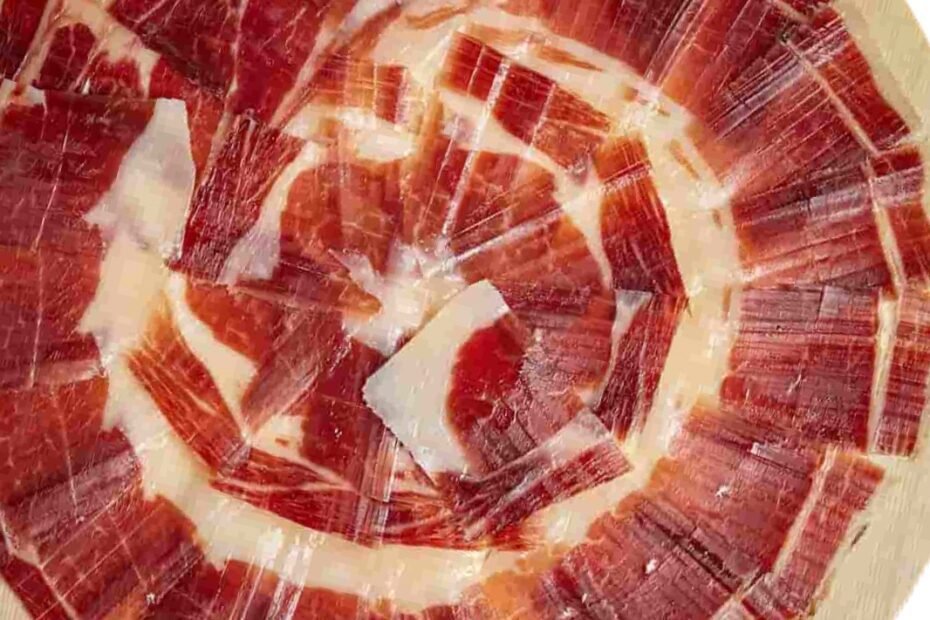If paella is Spain’s soul, Jamón Ibérico de Bellota is its heartbeat—a slow, deliberate rhythm shaped by centuries-old tradition, oak forests, and the patience to wait years for perfection. To the uninitiated, it’s “just ham.” To those who know, it’s an edible heritage, protected by law, revered by chefs, and whispered about by travelers who once stood in a tapas bar, thin slice in hand, tasting something that seemed impossible from a pig and some salt.
A Brief History: From Roman Feasts to Global Icon
The roots of Jamón Ibérico stretch deep into the Iberian Peninsula, long before Spain existed as a unified country. The Iberian pig—dark-skinned, long-snouted, uniquely capable of storing fat within its muscle fibers—descends from wild boars that roamed these lands thousands of years ago.
Archaeological evidence suggests that the Celts and Iberians were curing pork as far back as 1,000 BCE. When the Romans conquered Hispania, they quickly recognized the quality of local pork and shipped hams to every corner of their empire.
Through the Visigothic era and into Moorish rule (when pork consumption largely paused for religious reasons), the tradition survived in Christian mountain villages. By the Middle Ages, ham was firmly established as a celebrated product of Christian Spain.
Over time, the southwestern oak forests of Extremadura, Andalusia, and Salamanca became the heartlands of the finest hams—thanks to the practice that still defines de bellota quality today: the montanera, or acorn-feeding season.
Today, Jamón Ibérico de Bellota holds DOP (Denominación de Origen Protegida) status, which legally protects its production methods, geographic origin, and breed standards.
The Iberian Pig: Born for Bellota
Not every pig can produce Jamón Ibérico de Bellota. The Iberian breed is genetically special:
- Intramuscular fat storage: Marbling comparable to Wagyu beef, which melts at low temperatures.
- Foraging metabolism: Able to walk miles daily, gaining weight slowly while developing muscle tone and fat distribution.
- Black hooves (pata negra): A visible hallmark of the breed.
To qualify for de bellota, pigs must be at least 50% Iberian bloodline (though the most prized are purebred 100%).
Step-by-Step: From Acorn to Slice
Think of Jamón Ibérico de Bellota not as a single recipe, but as a four-year performance, with farmers, foragers, and master curers each playing their part.
1. Breeding & Early Life
Spring litters are raised free-range in oak-filled dehesas. For the first 10–12 months, their diet is a mix of grasses, herbs, and natural forage. By autumn, they weigh around 90–100 kg.
2. The Montanera (Acorn-Fattening Season)
From October to February, each pig roams at least 1 hectare of dehesa. They feast on bellotas (acorns) from holm and cork oaks, plus wild herbs and roots.
- Acorn magic: Rich in oleic acid, acorns produce fat that’s soft, aromatic, and healthy.
- In 3–4 months, a pig can gain up to 60 kg, purely from this natural diet.
3. Slaughter & Shaping
By late winter, pigs reach 160–180 kg. The hind legs are carefully trimmed into the distinctive ham profile, leaving a layer of protective fat.
4. Salting (Salado)
Legs are buried in sea salt for 1–2 days per kilogram of weight. Salt draws out moisture and starts the preservation process. Temperature: 0–4°C.
5. Washing & Resting (Asentamiento)
Excess salt is brushed away, and the legs rest in cool chambers for 30–90 days, allowing salt to penetrate evenly.
6. Natural Drying (Secado)
Hams hang in airy, mountain-side rooms for several months. No forced heat—just seasonal breezes that coax out moisture while concentrating flavor.
7. Cellar Aging (Maduración)
The real artistry begins here. In bodegas (aging cellars), hams mature for 36–48 months, sometimes more. Enzymes break down muscle fibers, and fats slowly oxidize, creating a deep, nutty aroma. Master jamoneros test quality by inserting a cala (a slender bone probe) into the ham and smelling the aroma.
8. Classification & Labeling
Only hams meeting the strictest criteria earn the de bellota designation:
- Black label – 100% Iberian, acorn-fed.
- Red label – 50–75% Iberian, acorn-fed.
9. Slicing & Serving
The leg is mounted on a jamonera stand, and slices are shaved paper-thin by hand with a long, flexible knife. Served at room temperature, the fat begins to glisten and melt instantly.
The Flavor Experience
- Texture: Silky, almost buttery, with delicate resistance.
- Aroma: Nutty, sweet, with hints of aged cheese and meadow herbs.
- Taste: Layers of sweetness, savory depth, and a lingering umami finish.
- Aftertaste: Clean and persistent, with no greasiness.
Cultural and Culinary Significance
Jamón Ibérico de Bellota is not everyday food—it’s a luxury that carries the patience of four years from birth to slicing. It appears at weddings, national celebrations, and Christmas tables, and is often the star attraction in high-end tapas bars.
Beyond prestige, it’s a symbol of Spain’s slow food ethos: heritage breeds, seasonal rhythms, natural landscapes, and the human craftsmanship that resists shortcuts.
